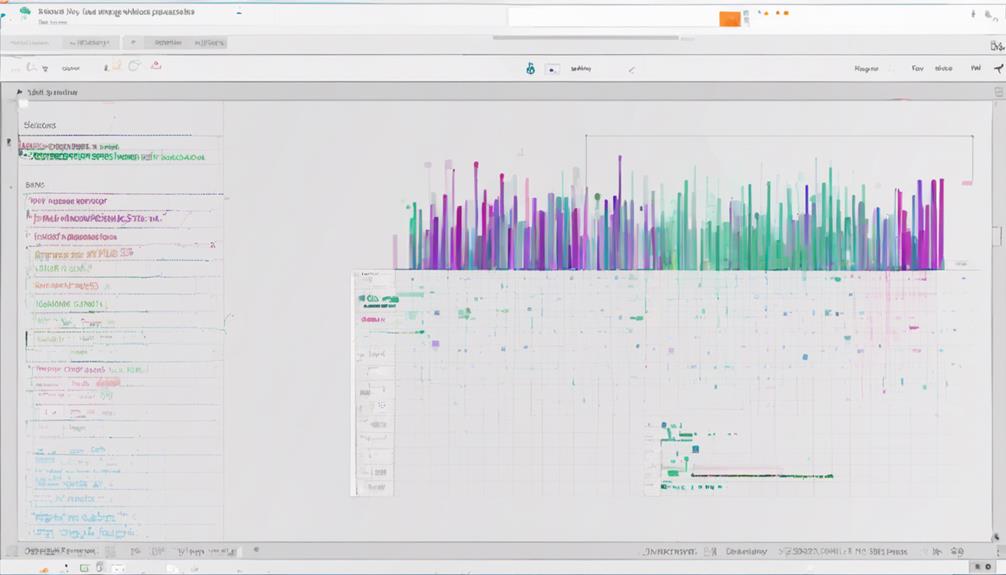As you navigate the realm of data scrubbing, you encounter a myriad of challenges in data scrubbing that demand your attention and expertise. From untangling the web of data complexity to safeguarding information in the face of evolving regulations, each hurdle presents a unique set of obstacles to overcome. But amidst these trials lie opportunities for growth and innovation, shaping the landscape of data management in profound ways. Stay tuned as we unravel the intricate tapestry of challenges that await in the realm of data scrubbing.
Data Complexity
Data complexity poses a significant challenge in data scrubbing. When dealing with large datasets, ensuring data normalization and validation becomes crucial. Data normalization involves organizing data into a consistent format, making it easier to identify duplicates or inconsistencies. Validation, on the other hand, confirms that the data meets specific criteria or follows predefined rules, ensuring its accuracy and reliability.
Moreover, data enrichment and profiling are key aspects of managing data complexity. Data enrichment involves enhancing existing data by adding supplementary information from external sources, enriching the dataset and providing more context for analysis. Data profiling, on the other hand, involves analyzing the data to understand its structure, quality, and completeness. This step helps in identifying potential issues such as missing values, outliers, or inconsistencies.
In the realm of data complexity, mastering data normalization, validation, enrichment, and profiling is essential for effective data scrubbing. By paying attention to these key elements, you can navigate the challenges posed by complex datasets and ensure the accuracy and reliability of your data.
Data Inconsistency
When it comes to data inconsistency, you’ll encounter missing data fields, which can disrupt the integrity of your dataset. Formatting variations pose another challenge, making it difficult to standardize information for analysis. Additionally, dealing with duplicate entries can lead to inaccuracies and skewed results in your data analysis processes.
Missing Data Fields
Addressing missing data fields is a crucial aspect of data scrubbing, as it directly impacts the reliability and accuracy of the dataset. Data validation plays a key role in detecting these missing fields, ensuring that the dataset is complete and consistent. When data fields are missing, it can lead to errors in analysis and decision-making processes. Error detection mechanisms help in identifying these gaps in the dataset, allowing for appropriate actions to be taken to either fill in the missing data or handle the absence in a way that does not compromise the overall integrity of the dataset.
To effectively address missing data fields, it is essential to have robust data validation processes in place. These processes should include thorough checks for missing values and mechanisms for flagging incomplete data entries. By implementing strong error detection methods, organizations can maintain the quality of their datasets and ensure that the insights derived from the data are accurate and reliable.
Formatting Variations
To effectively manage formatting variations in datasets, it is crucial to establish standardized data entry guidelines and protocols. Data standardization plays a vital role in ensuring consistency across different formats. By implementing data normalization techniques, you can transform data into a uniform structure, making it easier to analyze and process.
Data validation is another key aspect in handling formatting variations. Through rigorous validation processes, inconsistencies or errors in formatting can be identified and rectified. This step is essential in maintaining data accuracy and reliability.
Additionally, data cleansing procedures are instrumental in addressing formatting variations. Removing unnecessary characters, correcting misspellings, and ensuring uniform date formats are part of the data cleansing process. These actions contribute to streamlining the dataset and enhancing its overall quality.
Duplicate Entries
Dealing with duplicate entries poses a significant challenge in data management processes. Duplicate entries lead to data inconsistency, making it crucial to address them through effective data reconciliation and record matching. When multiple entries for the same entity exist within a dataset, it can result in errors, data redundancy, and inaccuracies. Identifying and resolving duplicate entries require meticulous attention to detail and analytical thinking.
Data reconciliation involves comparing and resolving inconsistencies between duplicate entries to ensure data integrity. This process involves identifying similarities and differences between records and merging or eliminating duplicate data points. Record matching plays a vital role in detecting duplicate entries by comparing various attributes and fields within datasets to find matching patterns.
Efficiently managing duplicate entries is essential for maintaining clean and reliable data. By implementing robust data reconciliation techniques and accurate record matching processes, organizations can ensure the consistency and accuracy of their data, thereby enhancing decision-making and overall operational efficiency.
Data Duplication
When dealing with data duplication, the crucial task lies in identifying duplicate records within datasets. Various de-duplication techniques are employed to cleanse the data and ensure accuracy. By implementing effective strategies, you can streamline the process of identifying and eliminating duplicate entries, enhancing the overall quality of your dataset.
Identifying Duplicate Records
Identifying duplicate records, a crucial task in data scrubbing, requires a meticulous approach to ensure data accuracy and integrity. Record matching is the process of comparing data entries to identify duplicates based on specific criteria such as names, addresses, or unique identifiers. Duplicate detection involves running algorithms that flag records with similarities above a certain threshold, indicating potential duplicates.
To effectively identify duplicate records, you must carefully analyze each data field for inconsistencies or variations that could lead to false positives or missed duplicates. Pay close attention to spelling variations, abbreviations, and formatting discrepancies that might hinder accurate matching. Utilize advanced algorithms and fuzzy logic to account for minor differences and improve matching accuracy.
Regularly review and update your record matching criteria to adapt to evolving data patterns and new sources of duplication. By continuously refining your duplicate detection techniques and staying vigilant in your data scrubbing efforts, you can maintain a clean and reliable database essential for informed decision-making.
De-duplication Techniques
To effectively tackle data duplication issues, it is imperative to implement robust de-duplication techniques that streamline the process of identifying and eliminating redundant records. Data matching algorithms play a crucial role in this process by comparing data sets to identify similarities and potential duplicates. These algorithms use various techniques such as fuzzy matching, which allows for matching records that are not identical but share similar characteristics.
Record linkage techniques are also essential in de-duplication, as they help in associating related records from different data sources. By linking records based on common attributes like names, addresses, or other identifiers, duplicate records can be identified and merged or eliminated. Additionally, advanced algorithms like probabilistic record linkage enable more accurate matching by considering the probability of a match based on multiple attributes.
Data Accuracy
Maintaining data accuracy is paramount in the process of data scrubbing. Data accuracy ensures that the information within a database is reliable and free of errors. Data validation and data verification are essential steps in ensuring the accuracy of the data. Data validation involves checking the integrity and validity of the data, while data verification involves confirming that the data is correct and consistent.
To achieve data accuracy, thorough validation processes should be implemented to catch any inconsistencies or discrepancies in the data. By cross-referencing data with reliable sources and using validation rules, you can identify and rectify errors effectively. Additionally, regular data verification checks should be conducted to guarantee that the data remains accurate over time.
Inaccurate data can lead to flawed insights, poor decision-making, and wasted resources. Therefore, prioritizing data accuracy through rigorous validation and verification processes is crucial in the data scrubbing journey. By maintaining accurate data, you can enhance the overall quality and reliability of your database.
Data Security
When it comes to data security, utilizing encryption is essential to protect sensitive information from unauthorized access. Ensuring compliance with regulations is another crucial aspect to safeguarding data and maintaining trust with stakeholders. By implementing robust encryption techniques and adhering to relevant regulations, you can enhance the security of your data and mitigate potential risks.
Encryption for Protection
You can enhance the security of your data by implementing encryption measures. Encryption methods play a crucial role in safeguarding your sensitive information from unauthorized access. By encoding data into a format that can only be decoded with the right encryption key, you add an extra layer of protection to prevent cyber threats. Robust cybersecurity measures often include encryption protocols to ensure that even if data is intercepted, it remains unintelligible to anyone without the decryption key.
There are various encryption techniques available, such as symmetric encryption, asymmetric encryption, and hashing algorithms. Symmetric encryption uses a single key for both encryption and decryption, while asymmetric encryption involves a pair of keys – one public and one private. Hashing algorithms, on the other hand, convert data into a fixed-length string of characters, making it challenging for cyber attackers to reverse engineer the original information.
Implementing encryption for protection is a proactive approach to data security, ensuring that your valuable information remains confidential and secure from potential threats.
Compliance With Regulations
To further fortify your data protection strategy, ensuring compliance with regulations concerning data security is paramount. Regulatory requirements play a crucial role in safeguarding sensitive information and maintaining the trust of stakeholders. It is essential to stay updated on data security laws and standards to avoid costly penalties and reputational damage.
Data validation is a key aspect of compliance with regulations. Validating data ensures accuracy, completeness, and consistency, reducing the risk of errors and unauthorized access. Implementing robust validation processes can help in maintaining compliance with regulatory requirements effectively.
Regular audits and assessments are necessary to evaluate your data security measures and ensure alignment with regulatory standards. By conducting thorough reviews of your data handling practices, you can identify potential gaps and take corrective actions promptly.
Data Integration
Data integration plays a crucial role in the process of data scrubbing by consolidating data from various sources into a unified format. When it comes to data quality, integrating data ensures that inconsistencies, errors, and duplications are identified and rectified during the scrubbing process. By adhering to data governance principles, organizations can establish rules and policies that govern how data is integrated, ensuring compliance and consistency across all integrated datasets.
Effective data integration requires a systematic approach that involves mapping out data sources, identifying key data fields, and establishing protocols for merging disparate datasets. Through this meticulous process, data integration facilitates a seamless flow of information, enabling accurate analysis and decision-making based on clean, consolidated data. Moreover, by streamlining data integration practices, organizations can enhance operational efficiency and drive better business outcomes.
Data Privacy
Ensuring the confidentiality and protection of sensitive information is paramount in the realm of data privacy. Data breaches can have severe consequences, ranging from financial losses to reputational damage. When engaging in data scrubbing processes, it is crucial to prioritize the security of personal and confidential data. Data sharing, while essential for collaboration and analysis, also poses risks if not managed effectively. By implementing robust encryption protocols and access controls, organizations can mitigate the chances of a data breach occurring during data scrubbing activities.
Data privacy extends beyond mere compliance; it is about building trust with your stakeholders. Transparent data handling practices and clear communication about how data is being used are fundamental in fostering this trust. Regular audits and assessments can help in identifying vulnerabilities and ensuring that data privacy measures are up to date and effective. Remember, in the digital age, data is a valuable asset, and safeguarding it should be a top priority for any organization.
Changing Regulations
Amid the ever-evolving landscape of data management, organizations must navigate the complexities of changing regulations. Regulatory compliance is a critical aspect that organizations must adhere to in order to avoid penalties and maintain trust with their customers. Ensuring data validation processes align with these changing regulations is crucial to safeguarding the accuracy and integrity of your data.
As regulations evolve, it is essential to stay informed and adapt your data scrubbing practices accordingly. Regularly reviewing and updating your data validation procedures will help you meet the requirements set forth by regulatory bodies. Failure to comply with these regulations can result in fines, legal issues, and reputational damage for your organization.
Resource Availability
Navigating the challenges of data scrubbing also involves considering the availability of resources within your organization. When addressing data quality concerns, having access to sufficient tools and technologies is crucial. Ensure your organization possesses the necessary software for detecting and rectifying errors in your datasets effectively. Additionally, resource availability plays a significant role in data enrichment efforts. Adequate resources enable you to leverage external sources, such as data vendors or APIs, to enhance your existing datasets with valuable information. It is essential to evaluate whether your organization has the manpower and expertise required to carry out data enrichment processes successfully. Lack of resources in this area can hinder your ability to maximize the value derived from your data. Therefore, carefully assessing and optimizing your resource allocation for data quality and enrichment tasks is vital for overcoming the challenges of data scrubbing.
Cost and Time Constraints
Dealing with the challenges of data scrubbing involves carefully managing the constraints of cost and time. When considering cost and time constraints, implementing automation solutions is paramount. Automation can significantly reduce the time required for data scrubbing processes, thereby cutting down on costs associated with manual labor. However, while automation solutions can streamline the process, they also present scalability challenges. It is crucial to ensure that the chosen automation tools can handle increasing amounts of data without compromising accuracy or speed.
Balancing cost and time constraints requires a strategic approach. Investing in robust automation solutions may initially incur higher costs but can lead to long-term savings by improving efficiency and reducing manual errors. When evaluating different automation options, scalability challenges must be carefully assessed to guarantee that the solution can adapt to the evolving needs of the data scrubbing process. By addressing cost and time constraints through effective automation and scalability planning, organizations can optimize their data scrubbing efforts and enhance overall data quality.
Frequently Asked Questions
How Can Data Scrubbing Help Improve Decision-Making Processes?
Data scrubbing enhances data accuracy by removing errors, duplicates, and inconsistencies. This ensures reliable data for decision-making processes. Through effective data cleansing, you gain clearer insights that drive better business decisions, leading to improved outcomes.
What Are the Common Tools Used for Data Scrubbing?
You’ll commonly use tools like OpenRefine, Trifacta, and Talend for data scrubbing. These tools aid in data cleansing by detecting errors and inconsistencies, ensuring accuracy. Additionally, tools like Tamr and Dataiku assist in data enrichment for improved decision-making processes.
How Does Data Scrubbing Impact Overall Data Quality?
When you engage in data scrubbing, you enhance data accuracy, completeness, consistency, and relevancy. This meticulous process ensures that your data is reliable and valuable for making informed decisions, driving business success.
Can Data Scrubbing Be Automated for Large Datasets?
Yes, data scrubbing automation can handle large datasets efficiently. It boosts scalability and minimizes manual intervention. Challenges like complex data structures may still require human oversight. Automating data scrubbing enhances accuracy and streamlines the process.
What Are the Best Practices for Maintaining Data Integrity Post-Scrubbing?
After data scrubbing, prioritize data validation to ensure accuracy. Implement robust error detection mechanisms for ongoing maintenance. Regularly audit data integrity to prevent inconsistencies. Your diligence in maintaining clean data post-scrubbing is crucial for reliable analysis.



